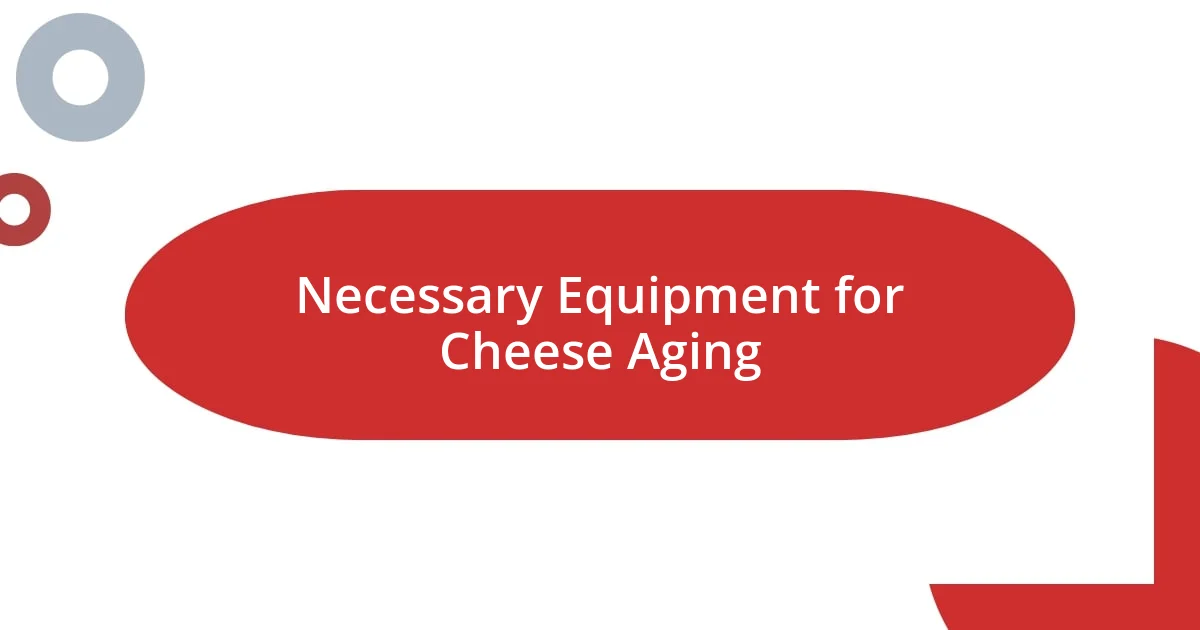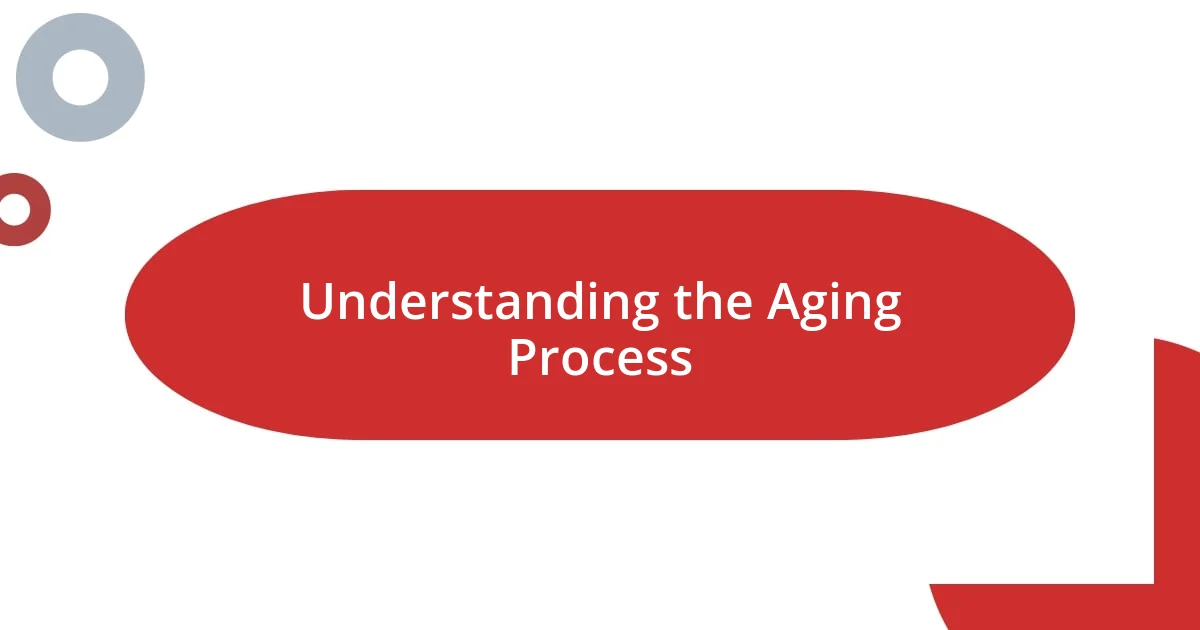Key takeaways:
- Investing in proper equipment, such as a dedicated cheese fridge and hygrometer, is essential for controlling temperature and humidity during the aging process.
- Understanding the characteristics of different cheese varieties, like hard versus soft cheeses, significantly affects aging outcomes and flavor development.
- Monitoring the aging process through regular notes, visual checks, and trusting your instincts enhances the overall cheesemaking experience and final product quality.

Necessary Equipment for Cheese Aging
When it comes to aging cheese at home, the right equipment can make all the difference. I remember my first cheesemaking adventure; I thought I could just use my regular fridge. What I didn’t realize at the time was that controlling humidity and temperature is crucial. That’s why investing in a dedicated cheese fridge, or even a wine cooler that allows for temperature control, is often a game-changer.
Humidity plays a significant role in the aging process, and I found myself confused at first about how to maintain it. A simple solution I discovered is the use of a hygrometer, which measures humidity levels. I can still feel the excitement of watching that little needle rise and fall, guiding my aging process. It made me wonder—how many backyard cheesemakers miss out on the magic of perfect humidity just because they overlook this basic tool?
Of course, I can’t forget about cheese molds and ripening boxes. When I first experimented with different types of molds, it felt like each one was a new adventure. There’s something delightfully personal about seeing how each mold influences the texture and flavor of the cheese. Have you ever thought about the impact a simple mold can have on your favorite cheese? If I hadn’t taken the plunge into trying different molds, I wouldn’t have discovered the complex depth they can add to my cheeses during the aging process.

Selecting the Right Cheese Varieties
Selecting the right cheese varieties for aging is essential, and it can really transform your cheese-making experience. From my own trials, I found that harder cheeses like Parmesan and Gouda age beautifully, developing deep, complex flavors over time. These varieties not only hold up well under the aging process, but they also allow you to explore the intricacies of taste and texture as they mature.
On the other hand, softer cheeses, such as Brie or Camembert, present their own delightful challenges. I remember my first attempt at aging Brie; it was a lesson in patience. The blooming rinds and creamy interiors can sometimes spoil if not monitored closely. This taught me a vital lesson about cheese varieties: understanding the aging requirements of your chosen cheese leads to rewarding outcomes.
Finally, the variety of milk used also matters when selecting cheese to age. Did you know that cow, goat, and sheep milks each impart unique characteristics to the cheese? I once aged a goat cheese that surprised me with its tangy notes, which intensified beautifully over time. Exploring different types of milk can open up a whole new world of flavor possibilities that just might leave you with a standout favorite.
| Cheese Type | Aging Characteristics |
|---|---|
| Hard (e.g., Parmesan) | Deep flavors, longer aging periods |
| Soft (e.g., Brie) | Requires close monitoring, develops creamy texture |
| Raw Milk (e.g., Goat) | Unique flavors, exciting variations |

Understanding the Aging Process
The aging process of cheese is fascinating, and I’ve learned so much through trial and error. I vividly remember the aroma that filled my kitchen the first time I opened a cheese aging box. That distinct smell, a blend of earthiness and richness, was a promising sign that I was doing something right. I realized that aging cheese isn’t just about time; it’s about carefully orchestrated conditions that bring out amazing flavors and textures.
Here are key factors that influence the aging process:
- Temperature Control: Keeping a consistent temperature is vital, usually between 50°F to 60°F (10°C to 15°C) for most cheeses.
- Humidity Levels: I learned that maintaining humidity around 80-90% prevents cheese from drying out, which is essential for smooth aging.
- Airflow: Proper airflow helps prevent unwanted mold growth. I often turn my cheeses to ensure even exposure.
- Time: Different cheeses require varying aging periods, with some aging for just a few weeks while others may need several months or even years.
Understanding these factors transformed my home cheese aging journey from a simple hobby into a flavorful adventure. I remember each time I tasted a new batch, it felt like unveiling a hidden treasure that spoke of patience and dedication.

Ideal Aging Conditions for Cheese
Creating the ideal aging conditions for cheese has been one of the transformative aspects of my cheese-making journey. I vividly recall the first time I set up my aging cave: I was both excited and a tad nervous. I realized that maintaining a steady temperature around 55°F (13°C) felt like nurturing a living being. It took me a few trials to find the perfect balance, but once I did, the depth of flavor in my cheeses truly began to shine.
Humidity is another crucial factor that I learned to respect. Initially, I underestimated how drying out could affect my cheeses. I remember discovering a rogue wheel of Gouda that had hardened improperly because I let the humidity dip below 70%. The heartbreak of that loss nudged me into investing in a hygrometer, which has since become one of my best friends in the cheese aging process. Keeping the humidity between 80-90% not only made my cheeses look appealing but also kept them wonderfully silky.
Airflow was a game-changer I initially overlooked. It wasn’t until I noticed some peculiar spots on my cheese that I realized the importance of rotation and ventilation. After a few weeks with a small fan gently circulating air, my cheeses not only aged more evenly but also developed a character that surprised me. I remember the first bite of that aged cheddar, my taste buds igniting with euphoria—it felt like a celebration of all the right choices I had made along the way. Isn’t it amazing how attention to detail can turn a simple piece of cheese into a culinary masterpiece?

Tips for Monitoring Cheese Aging
One of the most critical aspects of monitoring cheese aging is taking regular notes on your observations. I remember the first batch of cheese I aged; I’d hastily taste test without jotting down any details. It wasn’t until I noticed changes in flavor that I wished I had documented the process. Having a dedicated cheese journal where I record temperature, humidity, and even my personal tasting notes has made a world of difference. It’s captivating to look back and see how each element impacted the final product.
Checking the visual and textural changes in cheese is also a true delight. I once had a wheel of mozzarella that, at first glance, looked perfectly fine. But as I monitored it closely over weeks, I began to notice subtle shifts in color and texture that hinted at its developing personality. This hands-on engagement is part of the magic of aging cheese at home—each time you inspect your creation feels like a mini celebration. Watching cheese mature isn’t just a task; it’s becoming a part of its journey.
Lastly, always trust your instincts when it comes to scents. The aroma can tell you so much about your cheese’s progression. I recall smelling one of my aged Gouda wheels and thinking something was slightly off, even if it looked good. That gut feeling led me to check the humidity levels, and sure enough, they were dipping lower than I wanted. It’s these intuitive moments that create a deeper bond with your cheesemaking adventure. Have you ever followed your instincts to discover a hidden issue you might otherwise have overlooked? It’s all part of the process, and I assure you, staying attuned to your cheese pays off immensely in the flavor department!















